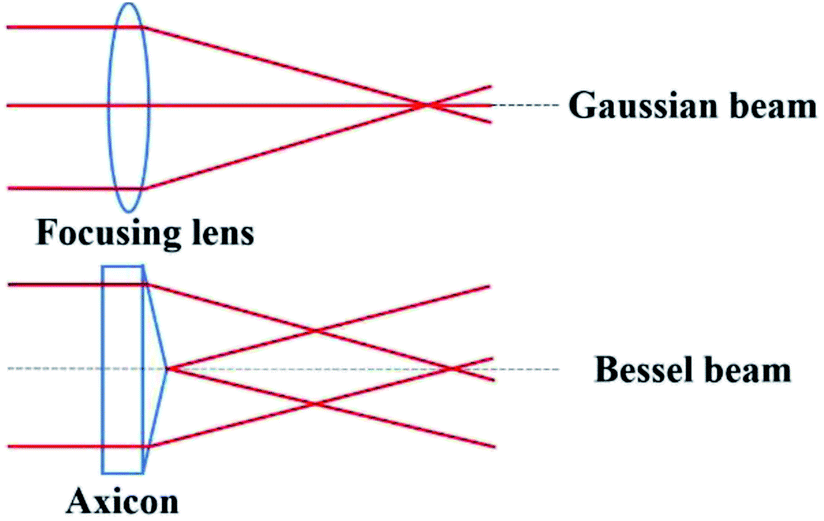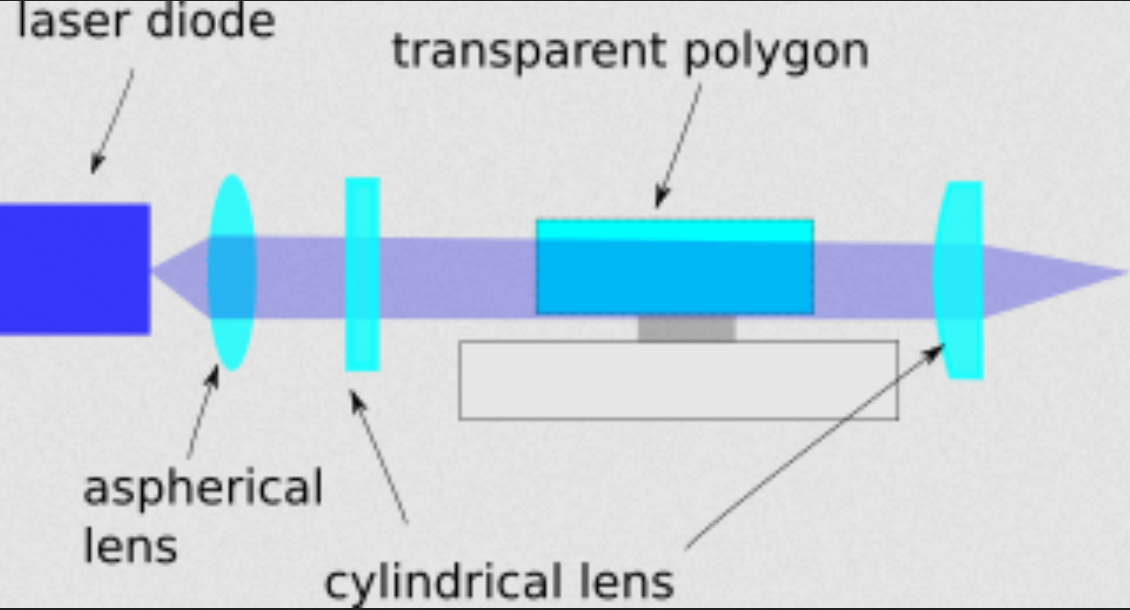Claim 1:
- I claim the use of two lenses which in combination focus light into a structured optical beam. Between these lenses there is a prism which can rotate so that a scanline can be formed. The first lens focuses the light parallel to the scanline and the second lens focuses the light orthogonal to the scanline.
Claim 2:
- The optical system of claim one, wherein the focal length of both lenses are different such that they circularize the light source.
Claim 3:
- The optical system of claim one, wherein each of these lenses is similar to an axicon. The difference with a normal axicon, is that each individual axicon focuses the light in one dimension and not two as a normal axicon. The light is just propagated and not diverted along the other axis. Only the combination focuses the light along two axes, one orthogonal and one parallel to the scanline.
Claim 4:
- The optical system as outlined in any of these above claims and in an applications outlined on (https://reprap.org/wiki/Open_hardware_fast_high_resolution_LASER) or https://hackaday.io/project/21933-prism-laser-scanner
Claim 5:
An optical systems similar to claim one, which is used in an optical tweezer or laser microscope.
I adapted this blog as it contained inconsistencies;
CERN provided more information here https://ventureconnect.cern/index.php/structured-laser-beam-slb
https://indico.cern.ch/event/707301/contributions/3073255/attachments/1699704/2736949/CESP_Structured_Laser_Beam.v1.pdf
Background
In the laser prism scanner, so far Gaussian beams are used. An alternative would be to use a Bessel beam. An advantage of a Bessel beam is that they have a longer depth of field as compared to a Gaussian beams for a given focus size. A true Bessel beam is non diffracting.
True Bessel-beams are not possible as they require infinite energy. Bessel beams can be approximated and then called structured light.
These structured light beams are less diffractive than Gaussian beams.
A Gaussian beam is created by focusing light into a point. Structured light is created by focusing light along a line. This is denoted by Bessel beam in the figure below.

Recently, companies such as ASML, Europe's most valuable tech firm according to BBC, started to support laserscan startups such as Inphocal which use structured light. Inphocal is based on intellectual property from Cern (WO2019211391A1) Inphocal received funding from HighTechXL, NWO, DeeptechXL and the European Union.
CERNs contributions to Kicad are highly appreciated. WO2019211391A1 feels incomplete. In short it outlines an improved version of the axicon. This new lens produces a beam which better approximates a Bessel beam and diffracts less. I can understand this due to the greater design freedom as the shape seems mathematically more general to me, but still I would be interested to see the actual differences backed up by optical simulations. The authors from CERN do not provide this. CERN furthermore does not really goes into the difficulties which arise by scanning a laser bundle. I can imagine Inphocal uses a galvo scanner from scanlabs and does not have a challenge with cross scan errors. Galvo scanner are slower than polygon scanners.
In specific, the authors do not outline how the movement orthogonal to the scanline can be mitigated if a Bessel beam is scanned by a prism. Given my experience with cylindrical lenses and Gaussian beams. I propose a similar solution for Bessel beams.
For Gaussian beams, my solution is outlined below;

Light diverges from a laser diode and is collimated by an aspherical lens. The first cylindrical lens focuses the light parallel to the scanline and the second cylinder lens focuses the light orthogonal to the scan lens. As the cylindrical lenses have a different focal length. The elliptical laser spot is circularized. Furthermore, the second lens removes part of the cross scan errors created by not mounting the prism orthogonal to the rotation axis. Light will still be parallel after leaving the prism if the prism is perfect and as such be focused into the same point. Perfect means here that opposing faces of the prism are perfectly parallel. If this where not the case and it would be tapered, the outgoing rays would not be parallel to the incoming rays of the prism.
Please recap what happens. You could focus the light directly after it leaves the aspherical lens as a collimated bundle. The lens is split into two components and each component only focus along one axis. The light is not altered along the other axis by each component. My bet is that this trick for Gaussian beams can also be repeated for Bessel beams.
For Bessel beams we repeat this trick, here the cylindrical lenses are replaced by a pair of axicons. The difference being that normal axicons focus light along two axes where i focus light along one axis, similar to the Gaussian beams. Here again the focal length can be chosen so that the beam is circularized. If the first lens focuses light along the scanline and the second orthogonal to the scanline, part of the cross scan error can be removed.
This can again be repeated for the lens outlined by CERN in WO2019211391A1. This lens is split it into two lenses and a prism is placed between the lens. Again the beam can be circularized and the cross scan error can be removed.
The patent from CERN is pending and its final claims uncertain. I added a presentation on the topic.
 Hexastorm
Hexastorm
Discussions
Become a Hackaday.io Member
Create an account to leave a comment. Already have an account? Log In.